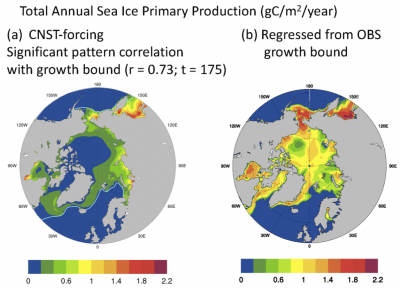Investigating Controls on Sea-Ice Algal Production Using E3SMv1.1-BGC
Sea ice algae are a fundamental source of primary production (PP) for polar zooplankton, particularly during the winter and early spring. In addition, there is growing evidence that sea ice primary production is likely critical for the health and survival of many polar fish, marine mammals, and seabirds. Understanding the changing role of sea ice algal production will provide key insights into the ecological integrity and stability of polar regions. Here we incorporate sea ice algal dynamics in 300 years of pre-industrial (CNST-forcing) and historical simulations of the E3SMv1.1-BGC global model to identify and quantify coupled constraints on sea ice PP.
Simulations of polar integrated sea ice primary production support the lower bound of published estimates for both polar regions with mean Arctic values of 7.5 and 15.5 TgC/a in the Southern Ocean. However, comparisons of the polar climate state with observations, using a maximal bound for ice algal growth rates, suggest that the Arctic lower bound is a significant underestimation driven by biases in ocean surface nitrate and that correction of these biases supports as much as 60.7 TgC/a of net Arctic primary production.
The E3SMv1.1 model includes a novel, eight-element sea-ice biogeochemical component which is resolved in 3D and uses a vertical transport scheme based on internal brine dynamics. Modeled ice algal chlorophyll-a concentrations are broadly consistent with observations, upper ice communities of the Southern Ocean are underestimated. Simulations of polar integrated sea ice primary production support the lower bound in published estimates for both polar regions, however correction of modeled upper ocean biases suggests that annual Arctic sea ice primary production may be as high as 60.7 TgC/a.

